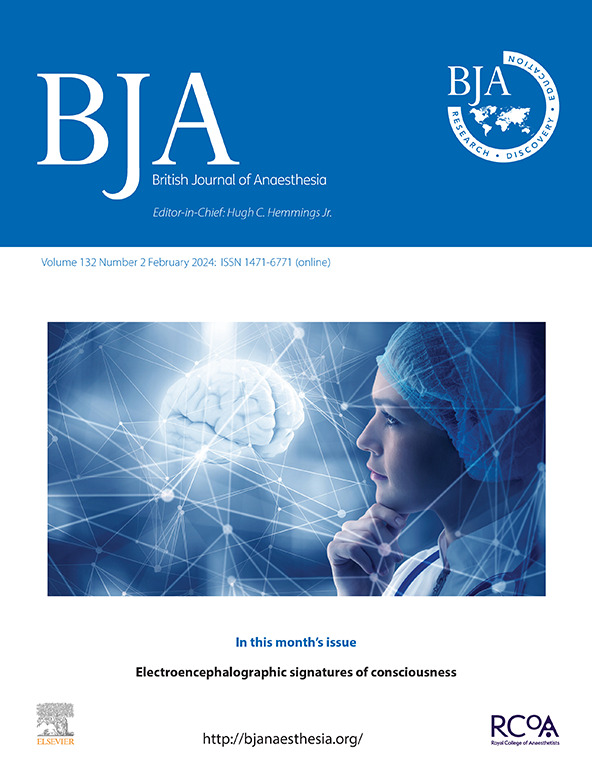Impact of age on the reliability of GE Entropy™ module indices for guidance of maintenance of anaesthesia in adult patients: a single-centre retrospective analysis
IF 9.1
1区 医学
Q1 ANESTHESIOLOGY
引用次数: 0
Abstract
Background
The GE Entropy™ module uses frontal EEG to compute the processed indices state entropy (SE), response entropy (RE), and burst suppression ratio (BSR) to guide maintenance of anaesthesia by supposedly minimising overly ‘deep’ or ‘light’ anaesthesia. It remains unclear whether the manufacturer-recommended index ranges accurately reflect anaesthesia levels or prevent complications such as burst suppression or arousal reactions.
Methods
We retrospectively analysed 15 608 patient records, evaluating 14 770 adult patients (18–90 yr old) undergoing general anaesthesia. Age-dependent effects on processed index values were assessed using linear regression and Spearman's correlation coefficients (rho).
Results
During steady-state anaesthesia (BSR=0), only 38.4% (32.5–42.4%) of SE values were within the recommended range, with most values below the target. Age was positively associated with an increase in age-adjusted minimal alveolar concentration for volatile anaesthetics (adjusted [adj.] R2=0.18, P<0.001, rho=0.47 [0.20–0.70]). Despite this, SE paradoxically increased with age (adj. R2=0.45, P<0.001, rho=0.67 [0.51–0.79]). This trend persisted even during periods with positive BSR despite supposedly adequate SE values (adj. R2=0.73, P<0.001, rho=0.90 [0.80–0.95]). Maintaining anaesthesia within the recommended index range did not prevent positive BSR. Additionally, both frequency (adj. R2=0.70, P<0.001, rho=0.92 [0.85–0.95]) and duration (adj. R2=0.73, P<0.001, rho=0.89 [0.82–0.93]) of ΔRE-SE≥10, indicating arousal, increased with age.
Conclusions
Despite their intuitive appeal, the processed EEG index values SE, RE, ΔRE-SE, and BSR showed limited reliability in guiding maintenance of anaesthesia, especially in older patients. Anaesthesiologists should not rely exclusively on the recommended index value range, as it is often unattainable and does not prevent burst suppression or arousal indicators.
年龄对指导成年患者麻醉维持的GE Entropy™模块指数可靠性的影响:单中心回顾性分析
背景:GE Entropy™模块使用额叶脑电图计算处理后的指数状态熵(SE)、反应熵(RE)和突发抑制比(BSR),通过最小化过度的“深”或“轻”麻醉来指导麻醉的维持。目前尚不清楚制造商推荐的指数范围是否准确地反映了麻醉水平或预防并发症,如爆发抑制或唤醒反应。方法:回顾性分析15 608例患者的记录,评估14 770例(18-90岁)接受全身麻醉的成人患者。使用线性回归和Spearman相关系数(rho)评估年龄对处理指标值的影响。结果:在稳态麻醉(BSR=0)时,只有38.4%(32.5 ~ 42.4%)的SE值在推荐范围内,多数低于推荐范围。年龄与挥发性麻醉药年龄调整肺泡最小浓度升高呈正相关(调整后[adj] R2=0.18, P2=0.45, P2=0.73, P2=0.70, P2=0.73, p)结论:处理后的EEG指数值SE、RE、ΔRE-SE和BSR尽管具有直观的吸引力,但在指导麻醉维持方面的可靠性有限,特别是在老年患者中。麻醉师不应该完全依赖于推荐的指标值范围,因为它通常是无法达到的,并且不能阻止爆发抑制或唤醒指标。
本文章由计算机程序翻译,如有差异,请以英文原文为准。
求助全文
约1分钟内获得全文
求助全文
来源期刊
CiteScore
13.50
自引率
7.10%
发文量
488
审稿时长
27 days
期刊介绍:
The British Journal of Anaesthesia (BJA) is a prestigious publication that covers a wide range of topics in anaesthesia, critical care medicine, pain medicine, and perioperative medicine. It aims to disseminate high-impact original research, spanning fundamental, translational, and clinical sciences, as well as clinical practice, technology, education, and training. Additionally, the journal features review articles, notable case reports, correspondence, and special articles that appeal to a broader audience.
The BJA is proudly associated with The Royal College of Anaesthetists, The College of Anaesthesiologists of Ireland, and The Hong Kong College of Anaesthesiologists. This partnership provides members of these esteemed institutions with access to not only the BJA but also its sister publication, BJA Education. It is essential to note that both journals maintain their editorial independence.
Overall, the BJA offers a diverse and comprehensive platform for anaesthetists, critical care physicians, pain specialists, and perioperative medicine practitioners to contribute and stay updated with the latest advancements in their respective fields.

 求助内容:
求助内容: 应助结果提醒方式:
应助结果提醒方式:


